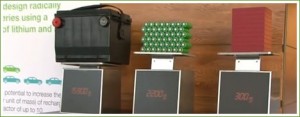Would a 500-mile electric vehicle battery interest you?

300 grams for the same amount of energy stored in a 15,900 gram lead-acid battery. That's of interest!
IBM, not normally thought of as a purveyor of electric vehicles, is backing a large-scale push from their Almaden Laboratory in San Jose, California, using the lithium-air battery demonstrated by recent experiments at the University of St. Andrews in Scotland, and the Universities of Strathclyde and Newcastle as a basis for their research. IBM is teaming with UC Berkeley and all five National Laboratories as part of Big Blue’s Big Green Innovations program. Initially launched as a means of reducing the 98 percent of carbon emissions from non-information technology related activities and the two percent from IT activities, the Big Green Initiative took a turn in the last several months toward the development of a 500-mile battery for electric vehicles.
According to IBM, “The 500 mile battery program’s goal “is to catalyze long-term, concerted efforts to create rechargeable next-generation batteries with ten times higher energy density, compared to the best current Lithium-ion batteries.”
“While scalable energy storage is critical to solving our biggest energy problems, progress has been slow. There are no fundamental scientific obstacles to creating batteries with ten times the energy content – for a given weight – of the best current batteries. ” IBM is using its peta-flop computers to model “complex chemical systems for electrolytes, catalysts and electrodes. Experimental studies will lead to new nanostructured surfaces, catalysts and membranes.”
Big Blue’s main concentration is on the lithium-air battery being researched at St. Andrews. In this battery, atmospheric air acts as the cathode in the battery, providing an unlimited reactant to the lithium anode. IBM is banking on its nano-technology to provide 100 times the current internal surface area of the best lithium-ion batteries on which electrical reactions can take place. Some criticism has been put forward because of the 10 million dollars that IBM is putting toward this effort, with some disappointed at the small percentage of IBM “green” money being expended.
